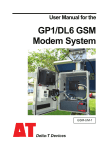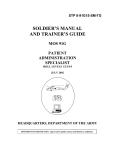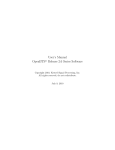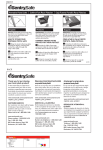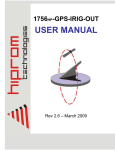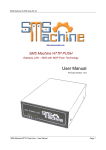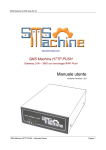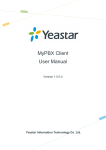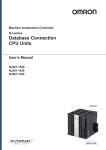Download 1756HP-GSM USER MANUAL
Transcript
1756HP-GSM USER MANUAL Rev 2.2.4 – April 2008 1756HP-GSM - User Manual Rev 2.24 Table of Contents Chapter 1 Chapter 2 Chapter 3 Chapter 4 Chapter 5 Chapter 6 Chapter 7 Chapter 8 Appendix A Appendix B Introduction.......................................................................................................3 Module Accessories .........................................................................................4 Module Operation.............................................................................................4 Installing the Module ........................................................................................5 Configuring the Module ....................................................................................6 I/O Address Map ............................................................................................14 Sending and Receiving a SMS ......................................................................17 GPRS Communication ...................................................................................28 Module Status ................................................................................................40 Specifications .................................................................................................43 . Page 2 of 43 1756HP-GSM - User Manual Rev 2.24 INTRODUCTION CHAPTER 1 Hiprom presents the 1756HP-GSM interface module. The 1756HP-GSM is an integrated GSM product that slots into the Allen Bradley ControlLogix PLC system. The 1756HP-GSM (master) module utilizes two forms of GSM communication to transmit information to/from the PLC: 1. 2. SMS (Short Message Service). GPRS (General Packet Radio Service) The module fits directly into any single slot within a ControlLogix System and is configured in RSLogix5000 using the Generic Profile. A SMA connector located on the underside of the module provides an interface to the antenna supplied. This document serves to describe the functionality, installation, configuration and use of the module. 1. SMS The Short Message Service (SMS), often called text messaging, is a means of sending short messages to and from GSM modules. 2. GPRS The General Packet Radio Service (GPRS) is a service that allows information to be sent and received across a mobile telephone network. It supplements today's Circuit Switched Data and Short Message Service. GPRS is not related to GPS (Global Positioning System). . Page 3 of 43 1756HP-GSM - User Manual Rev 2.24 CHAPTER 2 MODULE ACCESSORIES Each 1756HP-GSM package includes the following components: • • 1756HP-GSM module GSM Antenna with patch lead CHAPTER 3 MODULE OPERATION The 1756HP-GSM module is designed to operate within the Allen-Bradley ControlLogix PLC system. All power required for the module’s operation is derived from the 1756 backplane. Alphanumeric Display Status LEDs Reserved RJ45 Port SMA Connector Figure 3.1 : 1756HP-GSM Layout The current status of the module is conveyed to the user by means of the 3 bi-color Status LED’s and the alphanumeric LED display. Appendix A details the various states of the LED’s and messages of alphanumeric display. . Page 4 of 43 1756HP-GSM - User Manual Rev 2.24 The following information is available to the user directly across the backplane by means of a scheduled connection: • • • Status of the GSM module Signal Strength (Expressed in percentage %) Indication of new SMS and size of new SMS The SMA connector located on the bottom of the module provides an external connection for the GSM antenna. The module is supplied with the respective patch cable. Other information is also available with respect to the GPRS functionality: • • Local IP Address of SIM. Indication of received CSpeak / GPRS packet data. CHAPTER 4 INSTALLING THE MODULE The module is equipped with RIUP (Removal and Insertion Under Power) circuitry enabling the module to be installed or removed from the chassis while power is applied. . Page 5 of 43 1756HP-GSM - User Manual Rev 2.24 CHAPTER 5 CONFIGURING THE MODULE A direct connection between the controller and the 1756HP-GSM module is required to transfer I/O data to and from the module. Establishing the Direct Connection This section describes the procedures necessary to configure the 1756HP-GSM module within the ControlLogix system. Each 1756HP-GSM module must be owned by a single ControlLogix controller. The 1756 Generic Module is used in RSLogix5000 to configure the module. The configuration of the module is detailed in the tables below. Module Configuration: CommFormat Description Input Output Configuration RPI Data Format Data –DINT Connection parameters Instance 1 2 4 RPI 100 msec Size 63(32 Bit) 50 (32 Bit) 400 (8 Bit) Table 5.1: 1756HP-GSM connection parameters. . Page 6 of 43 1756HP-GSM - User Manual Rev 2.24 The steps required to add a new 1756HP-GSM module are detailed below. Figure 5.1 : Right-click on I/O Configuration and select New Figure 5.2: Select Generic 1756 Module (1756-MODULE) . Page 7 of 43 1756HP-GSM - User Manual Rev 2.24 Figure 5.3: Configure module’s parameters Figure 5.4: Configure module’s RPI (Requested Packet Interval) . Page 8 of 43 1756HP-GSM - User Manual Rev 2.24 The configuration data is defined in a UDT of type GSMConfig defined as follows: Figure 5.5: GSMConfig Configuration UDT Figure 5.6: Configuration ladder code In the above figure, GSMConfig is a user data type and is copied to the module in this manner. . The configuration data specifies the following: The PIN number of the SIM card The GPRS Listening Port Number The GPRS APN Name The GPRS Firewall IP The GPRS Firewall mask The GSM Module Mode The SMS Service Center Number . Page 9 of 43 1756HP-GSM - User Manual Rev 2.24 The different GSM Module types are: 0 1 – – Standard SMS Module (GSM, GPRS disabled) GPRS Module (GPRS, SMS also enabled) Note: The Configuration is ONLY read when the card initializes itself. If any data is changed, the card must be reset to enable the changes. The mode only needs to be set once. Very Important: When booting up the 1756HP-GSM module, enter the correct PIN number in the configuration. Booting up with the incorrect PIN 3 times will result in the SIM card being locked requiring a PUK security code. Below is an example of what the RSLogix Drop-down tree menu might look like: . Page 10 of 43 1756HP-GSM - User Manual Rev 2.24 Very Important: When booting up the 1756HP-GSM module, enter the correct PIN number in the configuration. Booting up with the incorrect PIN 3 times will result in the SIM card being locked requiring a PUK security code. The Configuration data is as follows: Figure 5.7: GSMConfig Configuration Should the SIM being used with the module require a PIN to be entered the Configuration data must be setup. For example should the PIN be “4743”, the above data would be entered. Once the module has been inserted into the rack and powered, the card will evaluate whether a PIN for the SIM is required. If a PIN is required the card will load the PIN configured in the Configuration Image. Once the SIM has been initialized correctly the module will attempt to establish connection with the GSM network. The Red GSM status LED (See Appendix A) should be on, and the Green GSM Registration LED will be flashing quickly. The module will take approximately 1 minute to configure and establish a connection with the GSM network. Once it has successfully connected the Green GSM Registration Status LED will begin flashing slowly. The module is now ready to send and receive SMSs or transmit/receive GPRS data. . Page 11 of 43 1756HP-GSM - User Manual Rev 2.24 The GSM_Status UDT is shown below as well as an example of a Tag with its corresponding example values. . Page 12 of 43 1756HP-GSM - User Manual Rev 2.24 The following ladder is added to the program to copy the status over from the card’s Input Image. . Page 13 of 43 1756HP-GSM - User Manual Rev 2.24 CHAPTER 6 I/O ADDRESS MAP The input and output image of the 1756HP-GSM module is defined in the following sections. Signal Strength 2 Received SMS Count CSpeak/GPRS RX GPRS Error Received SMS Text Size 4 Local IP Address(Hex) (Byte 4… Byte 1) (GPRS) 5 Last Connection IP FROM(Hex) (Byte 4 … Byte 1) (GPRS) 6 Ext Error Code 7 ContextNotOpenedCnt [H-int]CRC_ErrCnt[L-int] 8 Num_Activation_failedCnt [H-int] Num_IP_receivedCnt[L-int] 9 Internal_RecCnt[L-int] 10 Reserved 11 Reserved 12 RX Packet TNS_Num (H -int) GRPS Data Size to Follow(L-int) 3 2 1 0 Online [1] / Busy [0] Reserved 3 4 PIN Required 5 New SMS Received 6 SIM ERROR 7 PUK Required 8 GPRS Listen Mode Reserved 1 Reserved Error Code (0 - 255) Reserved Reserved Reserved 0 Reserved 9 Reserved Word 31 30 29 28 27 26 24 23 22 21 20 19 18 17 16 15 14 13 12 11 10 SMSmode(0)/GPRSmode(1) Input Image (32bit words) 13 … GPRS Data (50 DINTs Max) 62 Table 6.1: Connected Input Image Output Image Words 0...50 DINTs Word 0 1 2 3 4 5 …. Description Reserved Reserved Reserved Reserved Reserved Reserved Etc… . Page 14 of 43 1756HP-GSM - User Manual Rev 2.24 Input Image Description Field/Value Description Online [1] / Busy [0] New SMS Received PIN required PUK required SIM Error GPRS Error CSpeak/GPRS RX Error Code Location Type Local:s:I.Data[0].0 BIT Local:s:I.Data[0].1 BIT Local:s:I.Data[0].2 BIT Local:s:I.Data[0].3 BIT There is a problem with the module’s SIM card Local:s:I.Data[0].4 BIT There is a GPRS specific error. Local:s:I.Data[0].5 BIT Some form of CSpeak/GPRS packet has been received. 0 = GPRS request has been issued. 1 = New CSpeak/GPRS response has been received. Local:s:I.Data[0].6 BIT Local:s:I.Data[0].8..15 SINT Indicates that the module has successfully initialized and that the module is connected to the GSM network – indicates if module is busy Indicates new SMS received: 0 = No new SMS received 1 = New SMS received Indicates that the SIM card the module uses requires a PIN number to be entered. Please refer to the configuration of the module 0 = No PIN required 1 = PIN required Indicates that the SIM card the module uses requires a PUK number to be entered. The SIM needs to be removed from the module and configured. Should the module experience an error, an error code will be inserted. Signal Strength The strength of the signal expressed in percentage (%) Received SMS Count Number of SMS received. This Field will increment each time a new SMS is received Received SMS Text Size Ext Error Code Local IP Address Size of Received SMS Text This will indicate the size (number of characters) of the new SMS received. Local:s:I.Data[1] Local:s:I.Data[2] Local:s:I.Data[3] DINT DINT DINT Extended Error Code Local:s:I.Data[6] DINT Local IP address of Module This is the local IP address assigned to the SIM card by the network supplier. Local:s:I.Data[4] DINT . Page 15 of 43 1756HP-GSM - User Manual Rev 2.24 Last Connection IP FROM Shows the last IP address that has contacted this module. Local:s:I.Data[5] DINT CRC_ErrCnt [L-int] Number of CRC errors received. Local:s:I.Data[7] INT ContextNotOpenedCnt [H-int] Number of GPRS contexts that have failed. Local:s:I.Data[7] INT IP_receivedCnt[L-int] Number of times IP has been successfully returned from network. Local:s:I.Data[8] INT Activation_failedCnt [H-int] Number of times Context activation has failed. Local:s:I.Data[8] INT Number of Internal Network recoveries. Local:s:I.Data[9] INT Number that increments when Data Packet Arrives – Can be used to track Function 3 Data packet Arrival. Local:s:I.Data[12] INT The number of INTs that have been received from another GSM module. Local:s:I.Data[12] INT Local:s:I.Data[13].... Local:s:I.Data[62] DINT Internal_RecCnt[L-int] RX Packet TNS_Num (H -int) GRPS Data Size to Follow GPRS Data Physical data that has been received. Data is received. High_INT… Low_INT (16#54ae_6542) Table 6.2: Input Image description . Page 16 of 43 1756HP-GSM - User Manual Rev 2.24 CHAPTER 7 SENDING AND RECEIVING A SMS Sending an SMS SMS_Send Routine An SMS is sent by issuing a custom CIP message to the module. The ladder below is the recommended procedure to send the SMS using a timer. Figure 7.1: Send SMS Ladder Example Field Message Type Service Type Service Code Class Instance Attribute Source Length Destination Element Value CIP Generic Custom 0x32 0x71 0x01 0x01 184 bytes Destination tag for reply data The destination element is a dummy array and named “Response” or “SMS_Response”. . Page 17 of 43 1756HP-GSM - User Manual Rev 2.24 The message (SendSMSMsg) needs to be configured as follows: Figure 7.2: Send SMS Message Configuration The source tag/element “SMSSendReq” is a UDT (User Data Type) of type SMS_Sending, which is detailed below. Figure 7.3.1: SMS_Sending UDT . Page 18 of 43 1756HP-GSM - User Manual Rev 2.24 The SMS_STRING data type is defined as follows in the following diagram: Figure 7.3.2: SMS_STRING UDT . Page 19 of 43 1756HP-GSM - User Manual Rev 2.24 Example of sending an SMS Let’s assume we would like to send an SMS to “0851234567” with the text “Controller GSM: Trip on 12 March 2006 at 10:00, Line 2”. The source Tag “SMSSendReq” will be configured as follows: Figure 7.4: SMS Message Setup SMSSendReq.Message will be: Figure 7.5: SMS Message Note: The module is only capable of sending and receiving text of up to 160 characters. Note: CELL NUMBER IS IN ASCII format. . Page 20 of 43 1756HP-GSM - User Manual Rev 2.24 Receiving an SMS In the event of a new SMS being received, the module will: 1) Set bit 1 (“New SMS Received”) of Local:s:I.Data[0] 2) Increment Local:s:I.Data[2] (“Received SMS Count”) 3) Set Local:s:I.Data[3] (“Received SMS Text Size Count”) to the character size of the new SMS (refer to section 6.2). Field Message Type Service Type Service Code Class Instance Attribute Source Length Destination Element Value CIP Generic Custom 0x32 0x71 0x01 0x02 0 bytes Destination tag for reply data Figure 7.6: Read SMS Message . Page 21 of 43 1756HP-GSM - User Manual Rev 2.24 The response array holds the following data once a SMS has been received: Figure 7.7: Response Array Note: The Response array loads its INTEGER values low-byte first. Note: Message received in this example, above figure, is “Hello”. Response[21] … Response[23]. Note: This is viewed in ASCII style. . Page 22 of 43 1756HP-GSM - User Manual Rev 2.24 The following array positions are important: Note: Response[26] denotes array position “26” Array position 0 11 21 Description Start of Cell Number of Sending SMS SIM card Start of Date and Time Start of Message Received Table 7.1: Response Array positions Refer to Figure 7.7 when using this table. Note: The module is only capable of sending and receiving text of up to 160 characters i.e: Largest message Response[21]…Response[100] . Page 23 of 43 1756HP-GSM - User Manual Rev 2.24 SMS_Receive Routine The example code illustrates the recommended procedure to read a new SMS. Please note that once an SMS has been read the SMS will be deleted from the SIM card in the module to ensure that the card will not run out of memory. The ladder example code below thus stores all the received SMS in an array (SMS_List) of data type SMS_Received (as detailed in Figure 7.8.2). Figure 7.8.1: Processing Response Array . Page 24 of 43 1756HP-GSM - User Manual Rev 2.24 Figure 7.8.2: SMS_Received UDT Figure 7.8.3: Alternative SMS_Received UDT example . Page 25 of 43 1756HP-GSM - User Manual Rev 2.24 In Figure 7.8.1, SMS_List is an array of SMS data types to save received SMS’s with an increasing SMSIndex value. In this example, the cell number and received message are copied into their respective positions in a SMS data type. The message block is fired in the following manner based on the value of the LastSMSCount variable: Figure 7.8.4: Receiving Message Block firing . Page 26 of 43 1756HP-GSM - User Manual Rev 2.24 The following is a list of the parameters needed for sending and receiving SMS’s (using the sample code provided): Figure 7.8.5: Parameter List The following ladder rungs can be added to the “Main” routine – These load the Configuration image and fire the Send/Receive routines when applicable: Figure 7.8.6: Main Routine ladder . Page 27 of 43 1756HP-GSM - User Manual Rev 2.24 CHAPTER 8 GPRS COMMUNICATION GPRS Communication is accomplished by setting up a CIP Generic Custom message block. The 1756HP-GSM Master module is designed in such a way that it can establish a one-to-one GPRS connection with multiple slave modules. The Master connects to a slave, sends a request, receives the requested data, and then disconnects. The process of contacting one slave takes approximately 15 – 30 seconds under good signal conditions. This is dependent on network availability and good network conditions. The Master can contact multiple slaves in a “polling” fashion. Each slave is required to have a unique SIM card with a network-assigned unique IP address. GPRS communication is very cost effective and is calculated by the volume of data sent and received by each module, and not the time you spend connected. The GPRS communication uses a communication protocol called CSpeak. The following data characteristics are associated with this protocol: Minimum Packet Size Master Requests: Request Read OutputImage Request Write InputImage 14 Bytes 12 Bytes + Payload Slave Messages: Response Read OutputImage Response Write InputImage (Ack) 12 Bytes + Payload 14 Bytes . Page 28 of 43 1756HP-GSM - User Manual Rev 2.24 Data Cost Examples: Using an example Network Supplied SIM contract with the following details: Contract: R39-00 /month (Data included 5 Megabyte) Effective In-bundle rate R7.80 per MB Out-of-bundle rate R2-00 per MB (Approx. 7.8x10-6 cents per byte) Scenario 1 ONE 1756HP-GSM Master ONE 1756HP-GSM Slave a) We are sending a Request Read OutputImage ONCE every 10 minutes and we are requesting 10 Integers (16bit). (10 integers = 20 bytes) SIM Total: Per Day: 144 requests Sent + 144 messages Received a) (144 x 14bytes) + (144 x (12+20)bytes) = 6624 bytes Total for Master = 6624 bytes per day Total for Slave = 6624 bytes per day Total: 410688 bytes per month (31 days) per SIM card Total: R0.50 / month per SIM card Note: The Total bytes for the month is less than the data included in the contract therefore the Monthly cost will remain at R39-00 / month per SIM card. . Page 29 of 43 1756HP-GSM - User Manual Rev 2.24 Scenario 2 a) ONE 1756HP-GSM Master FIVE 1756HP-GSM Slaves AND b) ONE 1756HP-GSM Master FIVE 1756HP-GSM Slaves Each Master Communicating with 5 slaves (polling one at a time). a) We are Request Read OutputImage ONCE every 5 minutes from all 5 slaves of 50 Integers (100 bytes). b) We are sending a Request Write InputImage ONCE every 10 minutes to the other 5 slaves of 10 integers (20 bytes). a) SIM Total (per slave): Per Day: ((288 requests received) + (288 messages sent)) = (288 x 14bytes) + (288 x (12+100bytes)) = 4032 + 32256 = 36288 bytes. SIM Total (master): Per Day: 36288 x 5 = 181440 bytes. Total per day: 217728 bytes / day Total per month: 6749568 bytes (approx 6.7MB / month) Each Slave uses: 1124928 bytes (approx 1.1MB) per month Master uses: 5624640 bytes (approx 5.6MB) per month b) SIM Total (per slave): Per Day: ((144 Write InputImage Received) + (144 Acks sent)) = (144 x (12+20bytes)) + (144 x 14) = 6624 bytes. SIM Total (master): Per Day: 6624 x 5 = 33120 bytes. Each Slave uses: 205344 bytes (less than 0.5MB) per month Master uses: 1026720 bytes (approx 1MB) per month . Page 30 of 43 1756HP-GSM - User Manual Rev 2.24 Message Block Configuration: The configuration of the GPRS message instruction is as follows: Field Message Type Service Type Service Code Class Instance Attribute Source Length Destination Element Value CIP Generic Custom 0x32 0x71 0x02 0x01 232 bytes Destination tag for reply data Table 8.1.1: GRPS configuration. Figure 8.1.a: GPRS Message Block Configuration . Page 31 of 43 1756HP-GSM - User Manual Rev 2.24 Figure 8.1.b: GPRS Message Block Configuration Values Note: The Value of the Unconnected Message Block Timeout must be set to between 60seconds and 90seconds. Ie. 60000000 = 60s . Page 32 of 43 1756HP-GSM - User Manual Rev 2.24 Creating a Connection: To create a data transfer connection, we need a GPRS Message Block and a variable of the UDT GPRS_Connect_Request (called GPRS_Request in this example Fig 8.2 and 8.3). Using this variable we specify the IP address and Port Number we want to connect to as well as the Function Number we would like to use (with their respective other reference values). The IP address is the address associated with the SIM card (obtained through an APN) The Port number can range from 0…65535 Function Numbers: #2: Read the Slave’s OutputImage[size] (returns values to response array) Slave_Response_DataSize: Number of Integers required from slave. #3: Write Data to Slave’s InputImage (data is sent to slave module) DataSize: Number of Integers to send to slave. Data[0…99]: Physical data to send to slave. Figure 8.2: GPRS Connect Request UDT . Page 33 of 43 1756HP-GSM - User Manual Rev 2.24 Figure 8.3: GPRS_Request variable Function (2) will return the data into the destination response array with the following format: Field Response[0] Response[1] ….. Response[n] Bytes 2 2 2 Type INT INT INT Description Number of INTS requested. Slave’s OutputImage[0] Slave’s OutputImage[n-1] where n indicates the number of INTs requested. Table 8.1.2: GPRS Read OutputImage response. The Datasize of the GPRS payload it restricted to: Minimum: Maximum: 1 INT 100 INTs (2 bytes) (200 bytes) per message. . Page 34 of 43 1756HP-GSM - User Manual Rev 2.24 Function (3) returns an Acknowledgement and therefore no data will be loaded into the response array. The data that is sent to the slave is loaded into its InputImage starting at index position 12 (see Fig 8.4) Note: Local:s:I:Data[12] constitutes two INTs: HIGH-INT : Rx Packet TNS Number LOW-INT : Number of INTS that have been received. In Figure 8.4: Local:s:I:Data[12] = 16#0002_000a This means: TNS value is 2 (Three Function3 packets have arrived: 0,1 and 2) The data size is 10 INTS (0x000a) Data Received: Integer1: 0x0005 : Integer2: 0x0006 : Integer3: 0x0007 : Integer4: 0x0008 : Integer4: 0x0009 : Integer4: 0x000a : (decimal: 5) (decimal: 6) (decimal: 7) (decimal: 8) (decimal: 9) (decimal: 10) Figure 8.4: InputImage of GSM Module . Page 35 of 43 1756HP-GSM - User Manual Rev 2.24 The IP_Address data type is defined as: Figure 8.5: IP_Address Data Type The IP_Address field will only accept an IP address in the correct format. The format is [Byte1] [ . ] [Byte2] [ . ] [Byte3] [ . ] [Byte4] Example: 192.168.10.66 Note: If the IP address is in the incorrect format, the message block will Fail with Error Code: 16#0003 . Page 36 of 43 1756HP-GSM - User Manual Rev 2.24 Figure 8.6: Read OutputImage Message ladder example . Page 37 of 43 1756HP-GSM - User Manual Rev 2.24 Network Examples: Eg1: SMS Figure 8.7: SMS Network Example . Page 38 of 43 1756HP-GSM - User Manual Rev 2.24 Eg2: GPRS . Page 39 of 43 1756HP-GSM - User Manual Rev 2.24 APPENDIX A MODULE STATUS The following sections describe the status indicators of the module: A.1 Status LEDs of Display DESCRIPTION Module Status STATUS Solid Red Flashing Red Flashing Green Green MEANING Initialization or Watch Dog Fault Major Fault Minor Fault Module operating correctly A.2 GSM Status LEDs (Located on the bottom of the module) LED DESCRIPTION STATUS Solid Red RED Power Off GREEN Registration Status Flashing Quickly (Approx. Every 1 Sec) Flashing Slowly (Approx. Every 3 Sec) MEANING The GSM module is powered, and functioning properly No power is being supplied to the GSM module, the module is not operating correctly The Module has not established connection with the GSM network (Approx. every 1 Sec) The module has successfully established a connection with the GSM network. . Page 40 of 43 1756HP-GSM - User Manual Rev 2.24 A.3 Status Display Init Frn Conn PnOK PINx PUK Err GSM GPRS SMSr SMSt SSxx conA conS conE conR RptC Dsc√ CSP√ Ack√ RtCA Snt√ Initialization of Module The module is initialized only on power-up. Firmware Revision The firmware revision number is displayed on power-up. Establishing Connection The module is attempting to connect to the network. The PIN code has been accepted. The PIN code has not been accepted. PUK Required The SIM card requires the PUK code. Error Received An error has been received; see ERROR CODE in the InputImage. Module is configured as a standard GSM module. GPRS is disabled. Module is configured as a GPRS module Reading new received SMS from the module Transmitting an SMS from the module Signal Strength Xx is the GSM network signal strength expressed in percentage Connection Attempt Master module is attempting to establish a connection with a slave module. Connection Success GPRS connection has been successfully established, data communication will now follow assuming sufficient signal quality. Connection Failure GPRS connection has failed. See extended error code. Connection Received A successful GPRS connection has been received from a master module. Connection Retry Module is retrying the connection attempt. Disconnect Success Module has successfully Disconnected. Packet Received A CSpeak/GPRS data packet has been received. Acknowledgement Received A CSpeak/GPRS acknowledgment has been received. Context Retry Module is attempting to reset GPRS context. SMS Message Sent . Page 41 of 43 1756HP-GSM - User Manual Rev 2.24 A.4 Local Error Codes These error codes are located in Local:s:I.Data[0].16..23 as an SINT value. The error code will occasionally be echoed in the Extended error code DINT value (Local:s:I.Data[6]) Error Code 10 11 12 13 14 15 16 17 18 20 23 30 31 82 83 84 85 87 98 Description SIM not inserted SIM PIN required SIM PUK required SIM failure SIM busy SIM wrong SIM Code Incorrect SIM PIN2 required SIM PUK2 required memory full memory failure no network service / no balance on Sim network timeout Timeout in opening socket Connection failed Context not opened TX error Activation failed Already Listening (No Err) CRC Error LED Display (if any) NoSM SimE PUK SimE SimE SimE PINx PN2x PUK2 SimE SimE AIRx SimE Extended Error Code MSG Block Error Code (if any) 409 412 406 413 405 414 399 6 7 8 1 A.5 Message Block Extended Error Codes (SMS) Code Description 16#0000 0204 16#0000 0002 16#0000 0003 Message Block Timeout SMS timeout error. (potential network problem) SMS Sending error. Cell number and/or message incorrect format) A.6 Message Block Extended Error Codes (GPRS) Code Description 16#0000 0204 16#0000 0001 16#0000 0002 16#0000 0003 16#0000 0004 16#0000 0006 Message Block Timeout CRC Error GPRS Response has not been received correctly (potential signal / network problem) Request IP address incorrect format / length Module is in wrong Mode. Timeout in opening Socket. Slave might not be online. Network quality / antenna status might be suspect. Retry connect. Connection failed. Slave might not be online / Incorrect IP / Incorrect Port . Retry connect. Context Not Opened. Module will try to establish context. Retry connect. Internal Network Recover. 16#0000 0007 16#0000 0008 16#0000 000B . Page 42 of 43 1756HP-GSM - User Manual Rev 2.24 APPENDIX B SPECIFICATIONS Parameter Specification General Module Location Backplane Current RPI GSM Module: Max Average current consumption during GPRS transmission: Max Peak current consumption (impulsive): Antenna Connector Frequency Range Polarization Impedance VSWR Gain Weight Any Slot Electrical 515mA @ 5.1V 3mA @ 24V Schedules Connection Parameters 5ms to 750ms GPRS Specification Telit GE863-QUAD RoHS Compliant Quad Band GPRS Class 10 400mA 1.9A Antenna (GSM Shark Fin) SMA male connector 824 - 960 MHz and 1700 - 2170 MHz Linear (Vertical or Horizontal) 50Ω (nominal) < 2.5:1 1.5 dBi (± 0.5 dBi) (including cable losses) 300g . Page 43 of 43











































